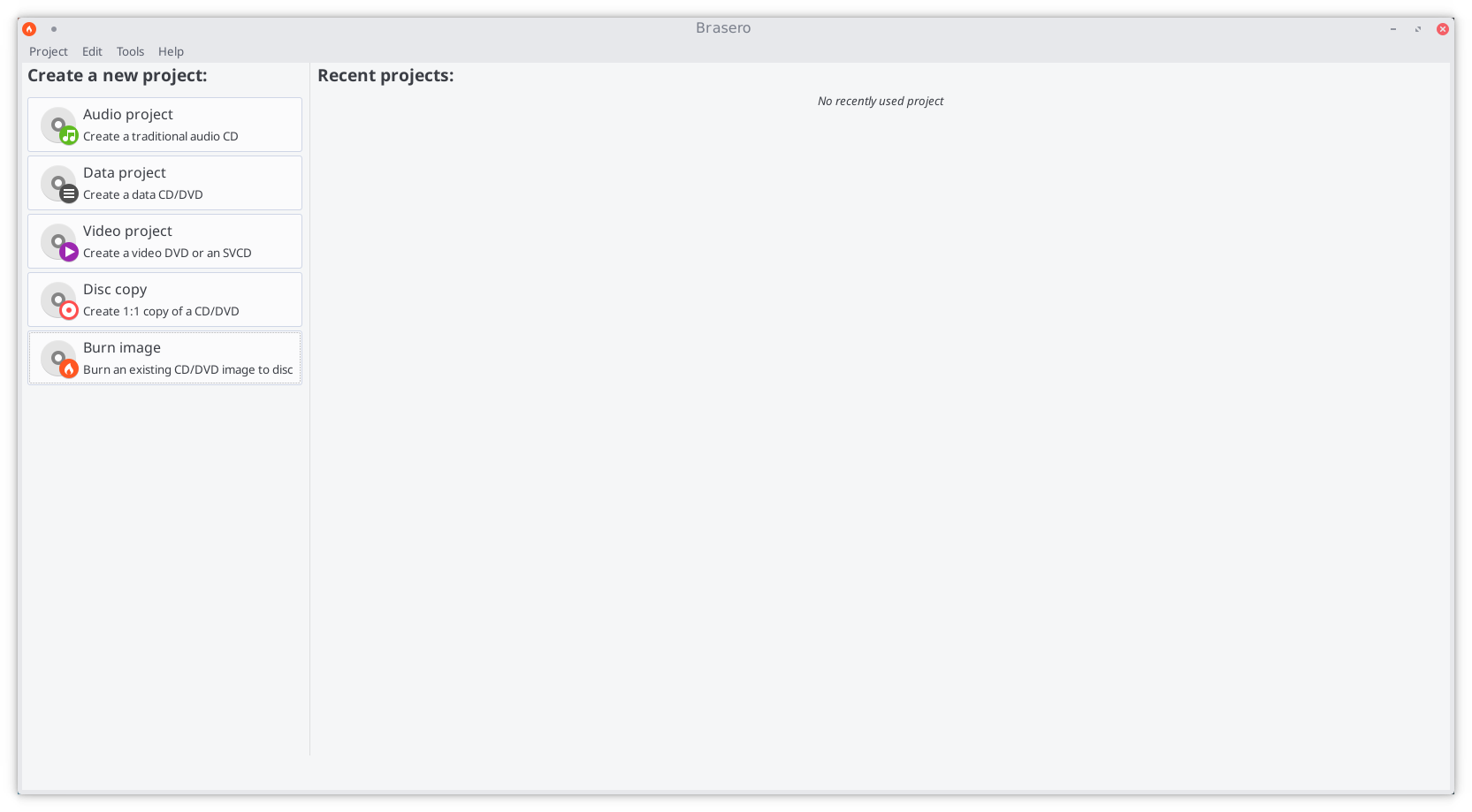Burn an ISO File
Views
Actions
Namespaces
Variants
Tools
Overview
As outlined in the Download Manjaro page, an ISO is not simply a 'drag and drop' or 'copy and paste' duplication of Manjaro's installation files. It is in fact a copy of the raw computer code that makes up the files themselves. This is why it is necessary to use a software burning application to 'burn' an ISO file, that is, convert its raw code into the files onto a physical medium such as a DVD or USB flashdrive / datastick in order to use it. Once burned / converted, the files on that medium can then be used to run Manjaro directly without having to install it to your system (referred to as Live-CD or Live-USB mode), and/or install Manjaro on your system. Again however, it will not be necessary to to burn an ISO if you intend on running Manjaro in a virtual machine environment using Oracle's Virtualbox. This is because Virtualbox is able to read ISO files directly as virtual disks.
Burning to CD/DVD in Linux
Several different software burning applications - if not already installed - should be available for installation from your distribution's Software Center / Software Manager / Package Manager / repositories. Popular burners include XFBurn, K3b, and Brasero. Which one you may choose is entirely down to personal choice. However, a guide to burning your downloaded Manjaro ISO using Brasero has been provided below:
1. Insert a Blank CD/DVD (use a DVD if burning an ISO for anything other than the NET Edition)
2. Start the Brasero software burner
3. Click the Burn Image - Burn an existing CD/DVD image to disc button to open the Image Burning Setup window.
4. Click the button beneath the title Select a disc image to write to open up your file manager. Locate and double-click the downloaded ISO file to load it. Upon automatically returning to the Image Burning Setup window, note that the ISO file is now listed as the disc image to write.
5. Underneath the title Select a disc to write to the blank CD/DVD inserted should already have been automatically listed. Otherwise, click the button to select it manually.
6. Click the properties button to open the properties window, and then click the button beneath the title Burning Speed. Again, it is strongly recommended to select the slowest speed available. Once selected, click the Close button.
7. Click the Burn button to start the burning process. If necessary, follow any on-screen instructions provided.
Burning to a CD/DVD in Windows
Several free software burner applications are available for Windows. Some popular examples of these include:
- Imgburn (Youtube video tutorial)
- Burn Aware free, and
- CDBurnerXP (Youtube video tutorial)
Writing to a USB Stick in Linux
This section describes how to write a Linux ISO file to USB.
Windows ISO files are notoriously difficult and requires special attention. Read the forum post on HowTo create a bootable Windows ISO
Using the Terminal
To burn the iso on an usb stick, enter the following command in a terminal :
sudo dd bs=4M if=/path/to/manjaro.iso of=/dev/sd[drive letter] status=progress oflag=sync
Where [drive letter] is the letter of your removable device. Please note that it is the device (e.g. /dev/sdb), and not the partition number (e.g. /dev/sdb1).
To find which drive letter it might be write:
sudo fdisk -l
Warning:
- Not all ISO are isohybrid ! However you can create isohybrid ISO.
- If you use very old hardware and rare, may not support isohybrid.
- Isohybrid created for UEFI should work with "Legacy mode", without support UEFI not will work on UEFI.
- Before use USB stick check Bios/UEFI settings, USB should start first.
- If isohybrid not working for you with uefi, try create isohybrid for own use without this option.
How you can check ISO
fdisk -l
- Example:
$ fdisk -l manjaro-mate-15.12-x86_64.iso Disk manjaro-mate-15.12-x86_64.iso: 7,5 GiB, 8006074368 bytes, 15636864 sectors Units: sectors of 1 * 512 = 512 bytes Sector size (logical/physical): 512 bytes / 512 bytes I/O size (minimum/optimal): 512 bytes / 512 bytes Disklabel type: dos Disk identifier: 0x00000000
$ fdisk -l manjaro-xfce-16.08-x86_64.iso Disk manjaro-xfce-16.08-x86_64.iso: 1,5 GiB, 1561657344 bytes, 3050112 sectors Units: sectors of 1 * 512 = 512 bytes Sector size (logical/physical): 512 bytes / 512 bytes I/O size (minimum/optimal): 512 bytes / 512 bytes Disklabel type: dos Disk identifier: 0x06c2dccb . Device Boot Start End Sectors Size Id Type manjaro-xfce-16.08-x86_64.iso1 * 0 3050111 3050112 1,5G 0 Empty manjaro-xfce-16.08-x86_64.iso2 224 63711 63488 31M ef EFI (FAT-12/16/32)
- Isohybrid have 2 partitions, you can check also with gparted after burn the iso on an usb stick.
How create isohybrid
isohybrid -v /path/to/name.iso
- or for UEFI
isohybrid --uefi -v output.iso
Using a Burning Application
ImageWriter
ImageWriter should be available for installation from your distribution's Software Center / Software Manager / Package Manager / repositories. Once Imagewriter has been downloaded and installed, ensure that your USB stick is plugged in before starting it.
A brief guide to writing the Manjaro .ISO image has been provided:
1. Click on the centre icon
2. Navigate to where the ISO image has been saved and select it
3. Ensure that your USB device has been selected from the drop-down menu
4. Click on the Write button
5. After the Write process has finished, reboot your system
Writing to a USB Stick in Windows
Using Rufus
Rufus Rufus is a utility that helps format and create bootable USB flash drives, such as USB keys/pendrives, memory sticks, etc.
When you use Rufus to write a Manjaro Live ISO to USB you must select DD mode when prompted to use standard or DD mode.
See its website for more details: [1]
